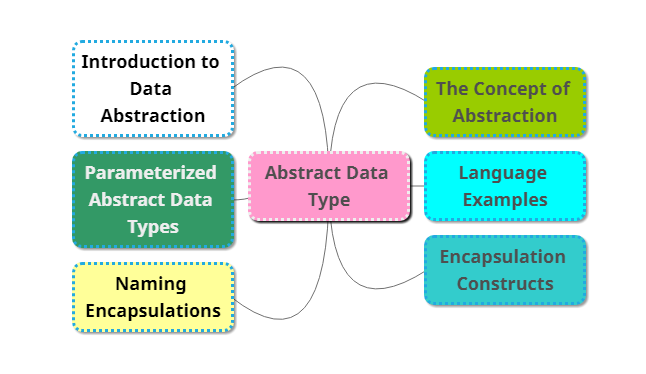Session VIII: Abstract Data Type
In this Session VIII : Abstract Data Type, there are 6 sub topics:
- The Concept of Abstraction
- Introduction to Data Abstraction
- Language Examples
- Parameterized Abstract Data Types
- Encapsulation Constructs
- Naming Encapsulations

The Concept of Abstraction
An abstraction is a view or representation of an entity that includes only the most significant attributes. In a general sense, abstraction allows one to collect instances of entities into groups in which their common attributes need not be considered. In the world of programming languages, abstraction is a weapon against the complexity of programming; its purpose is to simplify the programming process. It is an effective weapon because it allows programmers to focus on essential attributes, while ignoring subordinate attributes. The two fundamental kinds of abstraction in contemporary programming languages are process abstraction and data abstraction.
Introduction to Data Abstraction
The evolution of data abstraction began in 1960 with the first version of COBOL, which included the record data structure.1 The C-based languages have structs, which are also records. An abstract data type is a data structure, in the form of a record, but which includes subprograms that manipulate its data.
Syntactically, an abstract data type is an enclosure that includes only the data representation of one specific data type and the subprograms that provide the operations for that type. Through access controls, unnecessary details of the type can be hidden from units outside the enclosure that use the type. Program units that use an abstract data type can declare variables of that type, even though the actual representation is hidden from them. An instance of an abstract data type is called an object.
Here are some advantages of ADT :
–Reliability–by hiding the data representations, user code cannot directly access objects of the type or depend on the representation, allowing the representation to be changed without affecting user code
–Reduces the range of code and variables of which the programmer must be aware
–Name conflicts are less likely
–Provides a method of program organization
–Aids modifiability (everything associated with a data structure is together)
–Separate compilation
Language Examples
ADT in Ada
Ada provides an encapsulation construct that can be used to define a single abstract data type, including the ability to hide its representation. Ada 83 was one of the first languages to offer full support for abstract data types.

ADT in C++
C++, which was first released in 1985, was created by adding features to C. The first important additions were those to support object-oriented programming. Because one of the primary components of object-oriented programming is abstract data types, C++ obviously is required to support them.

ADT in Java
Java support for abstract data types is similar to that of C++. There are, however, a few important differences. All objects are allocated from the heap and accessed through reference variables. Methods in Java must be defined completely in a class. A method body must appear with its corresponding method header. Therefore, a Java abstract data type is both declared and defined in a single syntactic unit. A Java compiler can inline any method that is not overridden. Definitions are hidden from clients by declaring them to be private.

ADT in C#

Parameterized Abstract Data Types
It is often convenient to be able to parameterize abstract data types. For example, we should be able to design a stack abstract data type that can store any scalar type elements rather than be required to write a separate stack abstraction for every different scalar type. Note that this is only an issue for static typed languages. In a dynamic typed language like Ruby, any stack implicitly can store any type elements.
Classes can be somewhat generic by writing parameterized constructor functions
Example for Parameterized ADTs in C++

Encapsulation Constructs
When the size of a program reaches beyond a few thousand lines, two practical problems become evident. From the programmer’s point of view, having such a program appear as a single collection of subprograms or abstract data type definitions does not impose an adequate level of organization on the program to keep it intellectually manageable. The second practical problem for larger programs is recompilation.The obvious solution to these problems is to organize programs into collections of logically related code and data, each of which can be compiled without recompilation of the rest of the program. An encapsulation is such a collection. Encapsulations are often placed in libraries and made available for reuse in programs other than those for which they were written.
Naming Encapsulations
We have considered encapsulations to be syntactic containers for logically related software resources—in particular, abstract data types. The purpose of these encapsulations is to provide a way to organize programs into logical units for compilation. This allows parts of programs to be recompiled after isolated changes. There is another kind of encapsulation that is necessary for constructing large programs: a naming encapsulation. A naming encapsulation is used to create a new scope for names
C++ Namespaces
- Can place each library in its own namespace and qualify names used outside with the namespace
- C# also includes namespaces
Java Packages
- Packages can contain more than one class definition; classes in a package are partial friends
- Clients of a package can use fully qualified name or use the import declaration
Ruby classes are name encapsulations, but Ruby also has modules
Typically encapsulate collections of constants and methods
Modules cannot be instantiated or subclassed, and they cannot define variables
Methods defined in a module must include the module’s name
Access to the contents of a module is requested with the require method
No Comments »
RSS feed for comments on this post. TrackBack URL